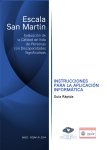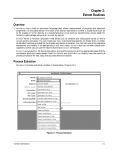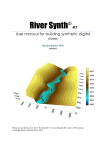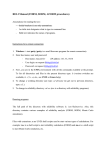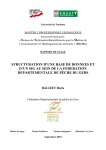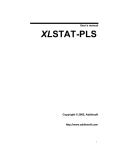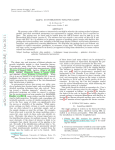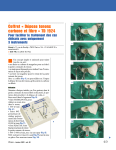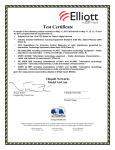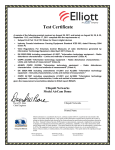Download Manual - Haneberg Geoscience
Transcript
PISA-m Map-Based Probabilistic Infinite Slope Analysis Version 1.0.1 User Manual Updated March 2007 PISA-m was developed by Haneberg Geoscience th 10208 39 Avenue SW Seattle WA 98146 USA www.haneberg.com [email protected] Copyright ©2006-2007 William C. Haneberg. All rights reserved. Licensees are given permission to make paper copies of this manual for their own use but may not distribute copies of the manual to others without permission. Licensees may also make a backup copy of the software or install it on more than one computer as long as no more than one person is using the program at any time. Any other duplication of this manual or the accompanying computer program is prohibited. Waiver of Liability Haneberg Geoscience does not warrant that this software is free from bugs, errors, or omissions; the product is sold as-is. Haneberg Geoscience shall not under any circumstances be responsible for any bugs, errors, or omissions; for corrections of any bugs, errors, or omissions discovered at any time; or for providing information about any bugs, errors, or omissions. Haneberg Geoscience does not recommend the use of PISA-m for applications in which bugs, errors, or omissions could threaten life, injury, or other significant loss. Moreover, Haneberg Geoscience does not warrant the suitability of this software or its results for any particular application. Considerable professional judgement is required of users when selecting input and interpreting results. Some applications of this program may constitute the practice of geology or engineering subject to local licensing laws. Under no circumstances shall Haneberg Geoscience be liable for any lost profits, lost benefits, or any other kind of damages. Liability shall be limited to the purchase price of the software license. Execution of the PISA-m computer program implies your acceptance of these conditions. What is PISA-m? PISA-m is a computer program that performs probabilistic static and seismic slope stability calculations for topography obtained from digital elevation models (DEMs). It is based on a first-order, second-moment (FOSM) formulation of the infinite slope equation used by the U.S. Forest Service slope stability program LISA and DLISA, and therefore can include the effects of tree root strength and tree surcharge. Although PISA-m does not perform a complete rigorous or simplified Newmark analysis, it calculates probabilistic Newmark acceleration values and compares them to a userspecified critical value to help identify locations where a more rigorous analysis may be insightful. The FOSM method used by PISA-m employs a non-iterative solution ideal for GIS-based analyses of watersheds or similarly sized areas covered by conventional or high-resolution LiDAR digital elevation models. The non-iterative nature is important because it means that reasonably accurate results can be obtained in a fraction of the time it would take to perform hundreds of iterations in a Monte Carlo simulation. PISA-m is an excellent complement to qualitative air photo or field-based landslide inventories, and can be used to evaluate the potential effects of logging or other activities on watershedscale slope stability, to assess the potential for landslide problems along transportation or utility corridors, to identify critical areas in land use planning and zoning projects, and to support EA/EIS analyses. PISA-m is a small program with a very specific job: to read in lots of numbers, perform some fairly complicated slope stability calculations, and save the results in a form that can be used in other programs. To that end, it has a bare bones command line interface in order to decrease development overhead and allow the same source code to be compiled for both Macintosh and Windows (and, in theory, any version of Unix or Linux for which a Fortran 95 compiler is available). In keeping with this bare-bones philosophy, PISA-m produces only numerical output and third-party GIS or graphics software is needed to display the results. The ASCII grid output produced by PISA-m is readable by many popular GIS and graphics programs (including the landscape analysis program Landserf, which is available for free from www.landserf.org, and the visualization software OpenDX, www.opendx.org). Installing and Running PISA-m PISA-m has been tested using Macintosh OS X 10.4 and Windows XP. Both versions are compiled from the same Fortran 95 source code and their usage is almost identical. Macintosh The Macintosh version of PISA-m runs in a Unix command line environment and is controlled using the Terminal application (located in the Utilities folder of the Applications folder). It will be easiest to use PISA-m if it is located in a directory along your specified file path, for example the usr/local/bin directory. So, place the pisam file there. To see what other locations are on your file path, type $PATH in the Terminal window and press return. You can modify your path, but should not try to do so unless you are an experienced Unix user, consult with your computer support staff, or read a Unix reference book. You may want to consult a Macintosh specific reference such as Unix for Mac by Sandra Henry-Stocker and Kynn Bartlett (ISBN 0-7645-3730X), which will also give a good introduction to Unix file manipulation commands that you may find useful. Once the pisam file is placed in a directory on your path, type pisam press the return key. You will see a screen that looks like Figure 1. Figure 1 As shown above, you’ll be prompted to enter the first of two file names, one for the input parameter file and the other for the output log file. The input parameter file will contain the names of other necessary input and output files. The log file will contain a summary of the data and parameters used in the model run. The next section describes the input file formats in detail, so please read it carefully. Input files that depart from the specifications will either cause a run-time error or, even worse, be used in calculations but produce incorrect results (especially if inconsistent units are used for the geotechnical variables). To make things easier, you can change the working directory to the directory containing the input files for your project using the Unix cd command. For example, if your input files are in the directory my_project/simulations then you would type my_project/simulations. You can verify that you’ve changed to the correct directory using the command pwd, which should return something like /Users/yourname/my_project/ simulations. Whether you type in the complete file path or cd to the directory containing the files, type in the file name and press return. It’s best not to use file or directory names with spaces when using Unix commands. Another way to specify the file is to find it in the Finder, copy its name, and paste it into the Terminal application before pressing return. Once you’ve entered the two file names, PISA-m will give you updates as it reads the files, performs calculations, and writes the output files. For very large DEMs containing millions of points, writing the output file is usually the most time consuming portion of the program. You can now examine the output files using the Unix cat (or, for large files, cat | more) command in the Terminal window, by opening them in a text editor, or importing them into a graphics or GIS program. Windows Using PISA-m in Windows is similar to using it in the Unix terminal window on a Macintosh, although the DOS command line interface is not as useful as the Unix command line. You can either double-click on the pisam.exe icon or use the Run… item under the main Windows menu. If you choose the second option, use Browse to select pisam.exe and click to OK button or place pisam.exe in the Program Files\bin directory. You will see a terminal window very similar to the Macintosh window illustrated above, prompting you to enter the first of four file names. Because pisam runs under DOS on Windows systems, it is limited to file names consisting of eight characters or less plus a period followed by a three character suffix. The next section describes the input file formats in detail, so please read it carefully. Input files that depart from the specifications will either cause a run-time error or, even worse, be used in calculations but produce incorrect results (especially if inconsistent units are used for the geotechnical variables). Rather than typing long file paths, you can drag files from the Desktop to the command line window and then press return. Once you’ve entered the two file names, PISA-m will give you updates as it reads the files, performs calculations, and writes the output files. For very large DEMs containing millions of points, writing the output file is usually the most time consuming portion of the program. You can now examine the output files using a text editor or importing them into a graphics or GIS program. Input and Output File Formats PISA-m requires four input files, three of which are in map form: a DEM, a soil unit map, and a forest cover unit map. The DEM consists of a grid of elevation values, whereas the soil and forest cover unit maps consist of grids of integer values corresponding to the entries in the parameter file discussed further on in this manual. Note that the PISA-m file format is different from the original PISA format and input files for the two programs are not interchangeable! PISA-m accepts maps (including DEMs) in either Arc ASCII grid format or Surfer ASCII grid format. In each case the file consists of a header followed by a grid of values representing elevations, soil unit types, or forest cover types. Although the grids are identical between the two formats, the headers are not. Therefore, users must specify which format is to be read. Specifying the wrong format will produce a run-time error and the program will stop. If you have a map file that is not in one of the two ASCII grid formats, you can convert it using many different GIS programs. The Arc ASCII grid format, in particular, in an almost universal file format. The free program Landserf (www.landserf.org) reads many common DEM formats and will export Arc ASCII grid files. Arc ASCII Grid Input and Output Here is an example of the 6 line header for an Arc ASCII grid file: ncols 450 nrows 300 xllcorner 1402500.0 yllcorner 150050.0 cellsize 50.0 nodata_value -32766.0 The ncols and nrows values are the numbers of columns and rows in the DEM. The next two variables, xllcorner and yllcorner, are the geographic coordinates of the lower left hand corner of the DEM. They are typically given as UTM coordinates or some kind of local coordinates (for example, state plane coordinates in the United States). The fifth variable, cellsize, is the DEM grid spacing, and must be in the same units as xllcorner and yllcorner. Finally, nodata_value is a number assigned to DEM grid points that have no elevation values. These might arise in a DEM that does not have a rectangular shape (for example, a DEM of an irregularly shaped watershed). PISA-m also uses nodata_value when it writes its results. This occurs for DEM grid points at which the slope angle is less than a user specified threshold and no calculations are performed, and for the grid points around the edge of the DEM. Slope angles are not calculated for points along the edge, so nodata_value is used to fill space and create an output file with the same number of rows and columns as the input file. The header is followed by 300 rows, each consisting of 450 columns, of elevation values separated by tabs or white spaces. Surfer ASCII Grid Input and Output The header for a Surfer ASCII grid version of the same DEM is: DSAA 450 300 1402500. 150050.0 -32766.0 1424950. 165000. 4218.1196 The first line of a Surfer ASCII grid file always consists of the identifier DSAA, which simply denotes that the file is in Surfer ASCII grid format. It does not identify the location or name of the DEM, just its format. The second line contains the numbers of rows and columns, but without any identifiers such as those used in the Arc ASCII grid format. The next three lines consist of the minimum and maximum x, y, and z values (in DEMs, these typically correspond to the East-West, North-South, and elevation values). PISA-m calculates a cell size value from the x and y data ranges, and will return an error message and quit if the cell size calculated from the x information does not equal that calculated from the y information. If that happens, check your input file for mistakes in the x and y value ranges. Surfer ASCII grid files do not contain a no data value, but PISA-m requires one and will prompt the user to enter a no data value from the keyboard. In the example used here, the DEM being read has a no data value of –32766 (the default value for some GIS programs). Because the Surfer format does not recognize the existence of no data values and the no data value is much smaller than any of the real elevation values, it appears as the lowest elevation value. Users should be aware that no data values far outside the range of the elevation data can complicate plotting in Surfer (and perhaps other programs), because the vertical axis will be automatically scaled to range from the no data value (in this case an elevation of –32766) to the maximum elevation value. It may help to specify the no data value as the smallest of the elevation values or zero. Programs specifically designed to deal with raster GIS data generally deal with no data values much better than does Surfer. Input File Consistency Regardless of which map format is used (Arc or Surfer), all three of the input map files must be of the same format and size. That means all of the information in the header lines must be identical among the three input maps, and maps of different sizes or geographic extent cannot be combined in a PISA-m run. Each value or raster in the soil and forest cover map files must correspond to an elevation value in the DEM input file. Parameter File Input The fourth input file required by PISA-m is a parameter file that contains information about the DEM, soil unit map, and forest cover unit map being used for the calculations; the statistical distributions of geotechnical parameters for each soil and forest cover unit; and geotechnical constants such as the unit weight of water consistent with the units being used for the geotechnical variables. The illustration below is a ascreen shot of a typical PISA-m parameter file opened by a text editor (for example, TextEdit on a Macintosh or Notepad on a Windows computer). Although it makes sense to give the parameter file a .par extension, for example project_name.par, this can cause confusion when using the Windows version because Windows will hide the extension. This problem does not occur on Macintosh computers. Here is a parameter file for the example data set included with your copy of PISA-m: seismic_d probability in_format arc out_format arc dem.asc soils.asc trees.asc results.asc gw 9810. an 0.39 dn 5 IA 2.0 minslope 5 z_err 0.05 soils 2 phi normal 33 0.81 0 cs normal 5500 42 0 d uniform 0.1 4 0 h extreme 0.5 0.1 0 gs normal 21500 22 0 gm normal 18000 25 0 phi uniform 32 0.81 0 cs none 10000. 39. 0 d uniform 0.1 4 0 h extreme 0.5 0.1 0 gs uniform 20000 26 0 gm normal 16500 32 0 trees 2 cr normal 2300 26 0 q normal 240 4 0 cr none 5000. 0 0 q normal 1100 17 0 Line 1 of the parameter file contains information about the mode of the model. It consists of two words. The first is static, seismic_a, or seismic_d for static conditions, seismic conditions in terms of the Newmark critical acceleration, or seismic conditions in terms of the Newmark displacement (using the simplified method of Jibson et al., 1998, US Geological Survey Open-File Report 98-113). The second entry on the first line is one of the following words: mean sd probability reliability This input tells PISA-m whether the output file should contain mean values, standard deviations, probabilities, or reliability indices. The meanings of each of these with respect to static and seismic slope stability calculations performed by PISA-m are listed in Table 1 and described in more detail in the Theoretical Background section. Lines 2 and 3 begin with in_format and out_format, respectively, and tell PISA-m what map formats to read and write. The choices for each line are arc and surfer. In the example shown above, the input and output maps are all in Arc ASCII grid format. Lines 4-7 contain four file names corresponding to the input DEM, the soil unit map, the forest cover unit map, and the output map. The four files must be listed in this order in order for the calculations to be performed correctly! Be sure to specify a complete and valid file path if any of the files do not reside in the current working directory. Value 1 static Value 2 Result Calculated mean Static factor of safety mean, FS sd Static factor of safety standard deviation, sFS probability reliability ( ) Newmark acceleration mean, aN seismic_a mean sd probability reliability seismic_d mean sd Static probability of sliding (lognormal), Prob [FS < ! 1] Non-parametric slope reliability,! FS "1 /sFS ! probability reliability Newmark acceleration standard deviation, sa N ! Probability that Newmark acceleration exceeds a user! specified threshold Prob[a N < acrit ] Non-parametric Newmark acceleration reliability, ! (aN " acrit ) /sa N Mean Newmark displacement, DN , in cm calculated ! using Jibson’s simplified method Option not available (s D N = ± 0.375 log cm ) Probability that the Newmark displacement exceeds a ! user-specified threshold Prob[DN > Dcrit] Non-parametric Newmark displacement reliability ! (DN " Dcrit ) / s DN Table 1 ! Lines 8-13 contain six geotechnical constants used in the calculations: the unit weight of water (gw), the user-specified Newmark acceleration threshold (an in g), the user-specifed Newmark displacement (dn in centimeters), the Arias intensity of the earthquake for Newmark displacement calculations (IA in m/s), the minimum slope angle (minslope), and the DEM elevation error standard deviation1 (z_err in units consistent with the DEM). The minimum slope value is used to prevent the calculation of extremely high factors of safety for low slopes. The equation to calculate the static factor of safety against sliding (which is also used by the seismic calculations) goes to infinity as the slope angle approaches zero, and Fortran will return a not-a-number (NaN) result if the slope is zero. In order to prevent that potential problem, PISA-m does not calculate factors of safety for grid points at which the average slope is less than minslope. The six values on lines 8-13 may be given in any order and may be set to zero if appropriate (for example, an and IA may be set to zero for static calculations). Although the geotechnical variables will be familiar to most geologists and engineers using PISA-m, the concept of elevation error standard deviation (z_err) may not. It is a measure of the uncertainty of elevations in the DEM from which slope angles are calculated. Field studies have shown that the elevation error variance varies in space and is spatially correlated, meaning that the value applicable to slope angle calculations will be less than DEM-wide RMS errors that are sometimes supplied as GIS metadata. It can be treated as a constant with a value of zero, implying that the DEM elevations are error-free, if this assumption is justified. GPS field studies have shown that in several cases the elevation error standard deviation of conventional DEMs with grid spacing on the order of 101 m (for example, off-the-shelf USGS 10 m and 30 m DEMs) can have quadrangle-wide elevation error variances on the order of ±2 to ±3 m. Because the errors are spatially correlated, though, the more relevant value is the standard deviation among points spaced 2 Δs apart, where Δ is the DEM grid spacing, which is likely to be on the order of 1 m. High-resolution LiDAR (airborne laser scanner) DEMs typically have much lower elevation error standard deviations, typically on the order of centimeters. Users should consult the following references for more information: Fisher, P., 1998, Improved modeling of elevation error with geostatistics: GeoInformatica, v. 2, p. 215-233. Haneberg, W.C., in press, Effects of digital elevation model errors on spatially distributed seismic slope stability calculations: An example from Seattle, Washington: Environmental & Engineering Geosciences. Holmes, K.W., Chadwick, O.A., and Kyriakidis, P.C., 2000, Error in a USGS 30-meter digital elevation model and its impact on terrain modeling: Journal of Hydrology, v. 233, p. 154-173. 1 This is a change from version 1.0, which used the variance of the elevation error. Line 14 contains the word soil and an integer indicating the number of units in the soil map. The example soil map provided with PISA-m has two soil units. Each of the soil units is described using six variables (phi, cs, d, h, gs, and gm) listed in any order. The first group of six lines corresponds to soil map unit 1, the second group to soil map unit 2, and so forth. See Table 2 for an explanation of the geotechnical variables. Each line consists of a variable name typed exactly as shown in the example parameter file above and Table 2, followed by a distribution type (none, normal, empirical, uniform, triangular, extreme, or beta_pert) and three numbers. The word none is used for variables that are to be treated as constants rather than random variables described by a probability distribution. It is to be followed by a value for that variable and then two dummy values. The dummy arguments can have any value, but they must be present because PISA-m expects to find three numbers and will produce an error if they are not. If the distribution type is normal, uniform, or extreme then two numbers— representing either a mean and standard deviation2 (normal or empirical), a location and scale parameter (extreme value type I distribution), or minimum and maximum (uniform distribution)— are followed by one dummy value. If the distribution type is triangular or beta_pert, the three numbers are the minimum, peak, and maximum values (triangular) or pessimistic, most likely, and optimistic values (β-PERT). Variable phi Explanation Angle of internal friction (degrees) cs Soil cohesive strength (pressure) cr Root cohesive strength (pressure) q Tree surcharge (pressure) d Soil thickness (length) h Pore pressure coefficient (0 ≤ h ≤ 1) gs Saturated unit weight (force/volume) gm Moist unit weight (force/volume) Table 2 2 This is a change from version 1.0, which used the variance instead of the standard deviation. After all of the soil units are described, the next line contains the word trees and another integer representing the number of forest cover units in the model. The example above contains two forest cover units, but they occupy different areas than the soil units (see Figure 2, which was produced by importing PISA-m input and output files into OpenDX). Each forest cover unit is described in terms of its root strength (cr) and surchage (q) in the same way as the soil unit map variables. Note that PISA-m assumes that the input variables have consistent units, and will perform calculations but return incorrect results if units are mixed! If soil thickness is specified using meters, then the pressure variables must be specified in units of Pa (not kPa). Also, remember that metric unit weights are given in terms of N/m3 and not kg/m3. The only exception is that the DEM and geotechnical units may be specified using different units because the only connection between them is the slope angle, which is always specified in degrees. Log File Output PISA-m produces a log file that echoes input information, the equivalent means and variances used in calculations, and other information for future reference. PISA-m will prompt the user for a file name, but no other action is required. If the file name is the same as an existing file name, PISA-m will overwrite the old file. Sample Data Set Your copy of PISA-m comes with a sample data set that you can use to examine the input file structure (especially the parameter file) and perform trial simulations. It is based on a 501 by 501 lidar DEM of a forested watershed. Figure 2 Theoretical Background Almost all existing spatially distributed rational slope stability models are based on variations of the infinite slope idealization. Although no slope perfectly satisfies the assumptions of the infinite slope model, many, if not most, natural landslides have relatively low thickness to length ratios and are predominantly translational. Therefore, although it is not suited for detailed design-level investigations, the infinite slope idealization provides a useful reconnaissance level approximation that can help to identify areas in which more detailed field investigations and office calculations are warranted. It is, in essence, a reconnaissance scale tool in much the same sense as a quadrangle or watershed scale geologic map. See Haneberg (2004, A rational probabilistic method for spatially distributed landslide hazard assessment: Environmental & Engineering Geosciences, v. 10, p. 27-43) for a more complete discussion of the methods used by PISA-m and a complete list of references. Haneberg (2000, Deterministic and probabilistic approaches to geologic hazard assessment: Environmental & Engineering Geosciences, v. 6, no. 1, p. 209-226) provides an overview of probabilistic methods, including a discussion of probabilistic slope stability analyses. Static Slope Stability PISA-m is based on the factor of safety against sliding for a forested infinite slope: FS = c r + c s + [qt + " m D + (" sat # " w # " m ) H w D] cos 2 $ tan % [qt + " m D + (" sat # " m )H w D] sin $ cos $ (1) in which ! cr cs qt !m ! sat !w D Hw ! ! = = = = = = = = cohesive strength contributed by tree roots (force/area) cohesive strength of soil (force/area) uniform surcharge due to weight of vegetation (force/area) unit weight of moist soil above phreatic surface (weight/volume) unit weight of saturated soil below phreatic surface (weight/volume) unit weight of water (9810 N/m3 of 62.4 lb/ft3) thickness of soil above slip surface (length) height of phreatic surface above slip surface, normalized relative to soil thickness (dimensionless) = slope angle (degrees) = angle of internal friction (degrees) The influence of groundwater is incorporated using a slope-parallel phreatic surface, so that the pore water pressure is the pressure exerted by a column of water equal in height to that of the phreatic surface above a potential slip surface. This is a common but not necessary assumption for infinite slope analyses. It is, however, reasonable in cases where a relatively permeable surficial deposit is underlain by less permeable bedrock. The variable Hw represents a normalized phreatic surface height that has a range of 0 to 1 for non-artesian conditions. PISA-m incorporates the effects of parameter uncertainty and variability using first-order, second-moment (FOSM) approximations, an approach that is firmly established in the geotechnical, hydrological, and geographical information system literature. A mean value of FS is first calculated using the mean values of each of the independent variables, or FS = FS ( x ) ! (2) For uncorrelated independent variables, the variance (or second moment about the mean) of FS can then be estimated by the first-order truncated Taylor series # "FS & 2 2 s = )% ( sx i i $ "x i ' x 2 F (3) 2 in which sx i is the variance3 of the ith independent variable. The terms in parentheses are ! evaluated using mean values for each of the independent variables (implying that each of the derivatives is a constant), and their squares are lengthy equations when all of the variables in equation (1) are included. The expressions used in PISA-m were derived using the symbolic manipulation capabilities of the computer program Mathematica, and the resulting expanded version of equation (3) occupies 26 lines in the Fortran source code. Input Probability Distributions Although FOSM approximations are often associated with normal distributions, this is not a necessary restriction. Any distribution for which a mean and variance can be derived can be used, although significant errors can arise if the distribution is not symmetric or nearly so. Therefore, PISA-m may not be appropriate if there is evidence that one or more of the input variables follows a strongly asymmetric distribution. PISA-m takes the customary parameters for each distribution as input and converts them to an equivalent mean and variance if the distribution is not normal. Four kinds of non-normal distributions are allowed: uniform, triangular, extreme value type I and β-PERT. Variables following uniform distributions have an equal probability of occurrence between a minimum and a maximum value. Extreme value type I distributions, which are sometimes referred to as Gumbel distributions, are characterized by a location parameter α and a shape parameter β. Triangular distributions are characterized by a minimum value, a peak value, and a maximum value. PERT is an acronym for Program Evaluation and Review Technique, and the β-PERT distribution is a variation of the β distribution developed to estimate the duration of complicated engineering projects such as ballistic missile development. β-PERT are also characterized by three variables— known as the minimum (or optimistic estimate), best estimate, and maximum (or pessimistic estimate)—but the distribution follows a smooth curve rather than a triangle and more emphasis is placed on the best estimate. Lognormal distributions are not included in PISA-m because in a FOSM approximation they are indistinguishable from normal distributions (their skewness and kurtosis are described by the third and fourth moments about the mean). PISA-m uses the following conversions for non-normal distributions: 3 Variance is the square of the standard deviation of a random variable. Uniform Distribution x= 2 x s x max + x min 2 ( x " x min ) = max (4 a,b) 2 12 Extreme Value Type I Distribution ! x = " + 0.577216 # s x2 = ! Triangular Distribution x= 2 x s = ! (5 a,b) $ 2# 2 6 x max + x apex + x min 2 x min ( x min " x apex ) + x peak ( x peak " x max ) + x max ( x max " x min ) (6 a,b) 18 β-PERT Distribution x= 2 x s x max + 4 x best + x min 6 ( x " x min ) = max 2 (7 a,b) 36 Slope Angle Means and Variances ! Slope angle variances are treated differently than geotechnical variables. The mean value for slope at DEM grid point (r, c) is estimated using a standard second-order accurate finite difference approximation % (z # z ) 2 + (zr +1,c # zr#1,c ) 2 ( * " r,c = arctan ' r,c +1 r,c#1 2$s '& *) ! (8) where β is in radians. PISA-m assumes that the elevation error in the input DEM is constant throughout the map area. In such a case, a FOSM expression for the slope angle variance at point (r, c) is 2 2 2 2. +$ #" r,c ' $ #" r,c ' $ #" r,c ' $ #" r,c ' 0 2 s = & ) +& ) +& ) +& ) sz -,% #zr +1,c ( % #zr*1,c ( % #zr,c +1 ( % #zr,c*1 ( 0/ 2 " (9) Evaluation of the derivatives yields ! 2 s"2 = 8(#s) sz2 [4(#s) 2 2 + ( zr +1,c $ zr$1,c ) + ( zr,c +1 $ zr,c$1 ) 2 2 ] (10) in which the variance has units of rad2. Examination of equation (10) shows that the slope angle variance will be inversely proportional to slope angle. In other words, a given ! elevation error will have a larger influence on slope angle uncertainty when the points being used to calculate the slope angle are similar in value than when they are different. Probability of Sliding Once the mean and variance of the factor of safety have been calculated, results can be expressed in terms of the probability of sliding or a slope reliability index. The former requires an assumption about the underlying probability distribution of the factor of safety whereas the latter does not. Numerical experiments using Monte Carlo simulations have suggest that the factor of safety distribution is generally described more faithfully by a lognormal distribution than the normal distribution. The probability of sliding is obtained from the cumulative distribution function for a specified probability distribution having the calculated mean and variance and evaluated at the critical value of FS = 1, or Prob{FS " 1} = CDF(FS(1)) (11) in which CDF(FS(1)) is the cumulative distribution function of FS evaluated at the limiting value of FS = 1. Equation (10) can be evaluated for any cumulative distribution ! function defined by a mean and variance, so it is not necessary to assume that the results are normally distributed. PISA-m assumes that FS follows a lognormal distribution. The probability of stability is the complement of the probability of sliding, or 1-Prob{FS ≤ 1}. The meaning of the probability given by equation (11) depends on the input variables. If one or more of the variables is specified as a constant, then it can be interpreted as a conditional probability for that value. For example, if h = 1 is specified for the pore water pressure, then the result is calculated probability is conditional upon the existence of complete saturation. If h is specified using an extreme value distribution derived from annual piezometric maxima, then the result is an annual probability of occurrence. Therefore, particular attention should be paid to the nature of the input distributions. See the following reference for a discussion of the physical meaning of the probabilities calculated by programs such as PISA-m and LISA: Hammond, C., Hall, D., Miller, S., and Swetik, P., 1992, Level I Stability Analysis (LISA) Documentation for Version 2.0: Ogden, UT, U.S. Department of Agriculture, Forest Service, Intermountain Research Station, Gen. Tech. Rep. INT-285, 190 p. Non-Parametric Reliability Index An alternative to the probability of sliding, and one which does not require an a priori assumption about the form of the output probability density function, is the reliability index RI = FS "1 sF (12) in which sF is the standard deviation of the factor of safety and unity is the limiting state value of the factor of safety (FS = 1). A value of RI = –2, for example, would indicate ! that the calculated mean factor of safety lies two standard deviations below the critical value of FS = 1. Values near zero indicate that stability or instability is inferred only with little confidence. Seismic Slope Stability PISA-m performs rudimentary seismic slope stability calculations but does not perform a rigorous or Newmark analysis. The seismic_a option performs calculations related to the Newmark critical acceleration, with the mean and variance given by aN = (FS "1)sin # (13) and ! 2 aN s 2 # "aN & 2 2 # "aN & 2 =% ( s +% ( s $ "FS ' FS $ ") ' ) ( ) 2 2 = FS *1 cos 2 ) s)2 + sin 2 ) sFS ! (14) where aN has units of g (gravitational acceleration) and sa2N has units of g2. As with the static factor of safety, the probability that aN is less than a user-specified acrit is found by from the cumulative distribution function. ! Prob{an " acrit } = CDF(aN (acrit )) ! (15) In this case, however, Monte Carlo simulations conducted during the development of PISA-m suggest that aN typically follows a normal, not log-normal, distribution ! (Haneberg, 2004, Computational Geosciences with Mathematica: Springer-Verlag). The Newmark critical acceleration reliability index is calculated using acrit as the limiting state value: RI = aN " acrit sa N (16) The Newmark acceleration aN is the acceleration that must be exceeded in order for slope movement to begin. Movement will not occur if the acceleration as a result of seismic ! shaking is less than that. Therefore, if a > a it is unlikely that seismic shaking will N crit trigger a landslide. The degree to which landsliding is unlikely is quantified by the probability and reliability index results. In contrast, if aN < acrit then seismic shaking may trigger a landslide if the shaking is prolonged and severe enough, and a more thorough rigorous Newmark analysis should be conducted. The second seismic option, seismic_d, estimates the mean Newmark displacement using Jibson’s simplified method: log10 DN = 1.521log10 I A "1.993 log10 aN "1.546 (17) where DN is the Newmark displacement in centimeters, IA is the Arias intensity in meters per second, and aN is the calculated mean Newmark critical acceleration for each grid ! point in the model. Equation (17) is based on a regression analysis of more than 500 strong motion records for 13 different earthquakes. It is statistically significant, and has a goodness-of-fit of r2 = 0.83 and model standard deviation of ±0.375. See Jibson et al (1998, US Geological Survey Open-File Report 98-113) for details. The mean value given by equation (17) and the model standard deviation are used to calculate the probability of that DN exceeds a user specified critical or a reliability index relative to that critical value. Selection of an appropriate critical DN value requires professional judgement and knowledge of soil types. Values typically range from about 5 cm in sands to 15 or 20 cm in clays, and sliding is predicted if the calculated DN exceeds the threshold. Please consult an appropriate engineering geology or geotechnical engineering reference for more details.




















